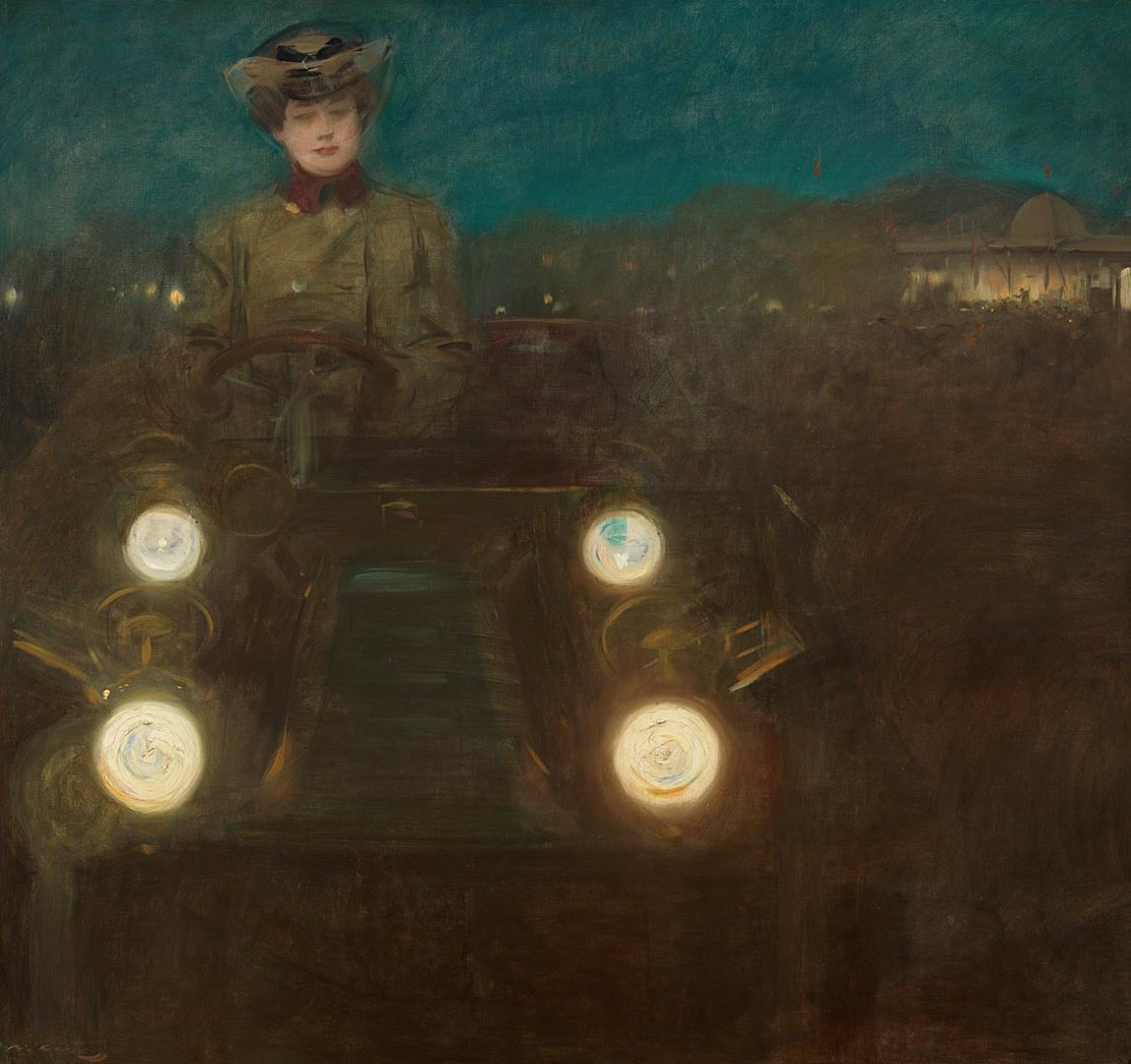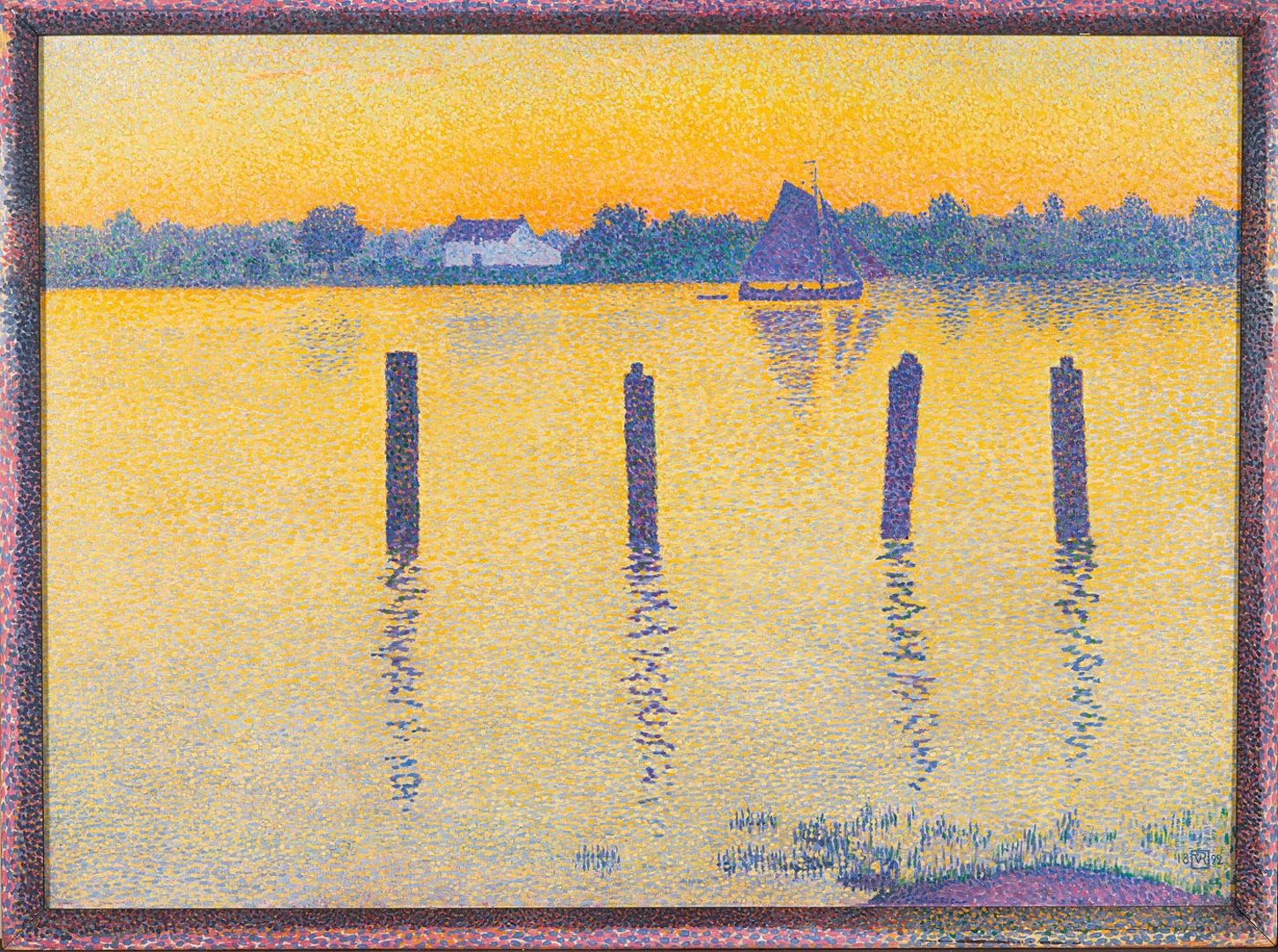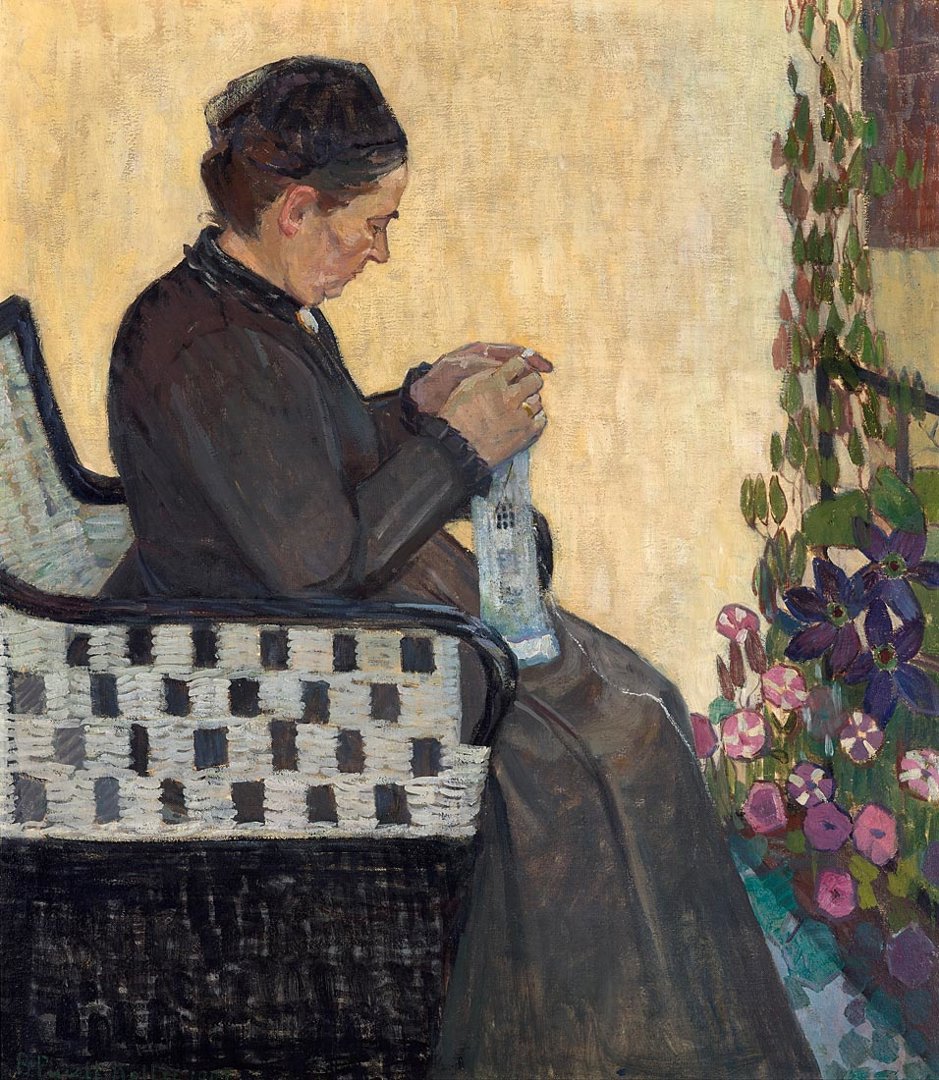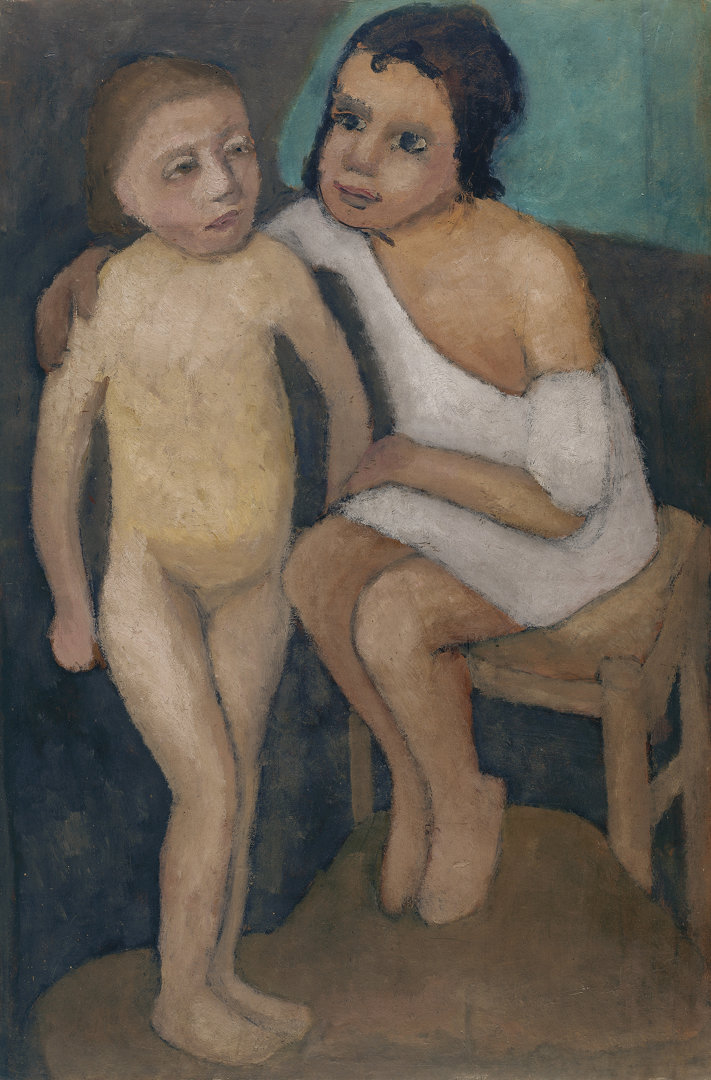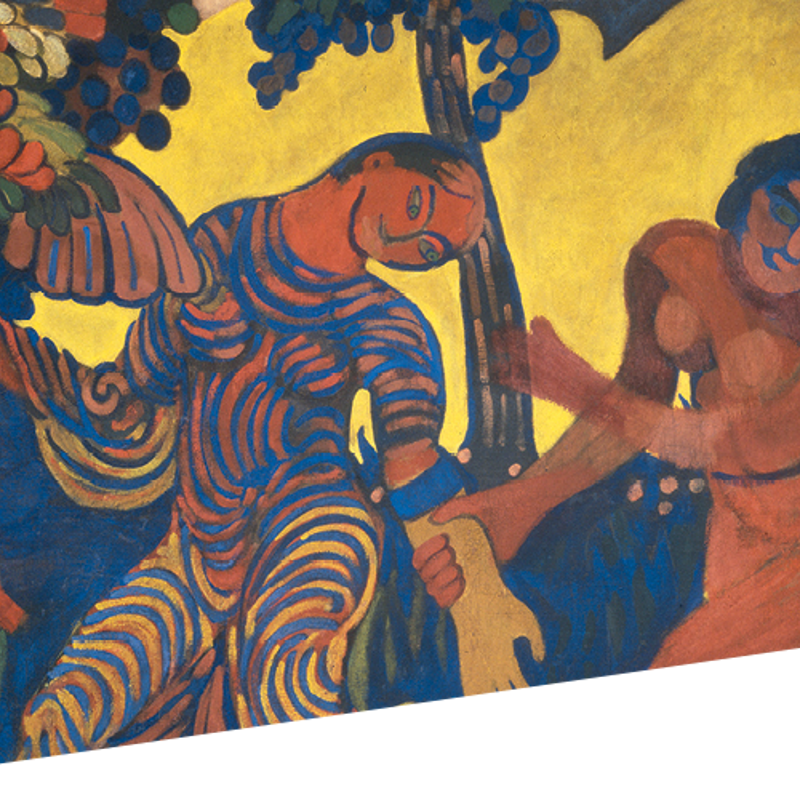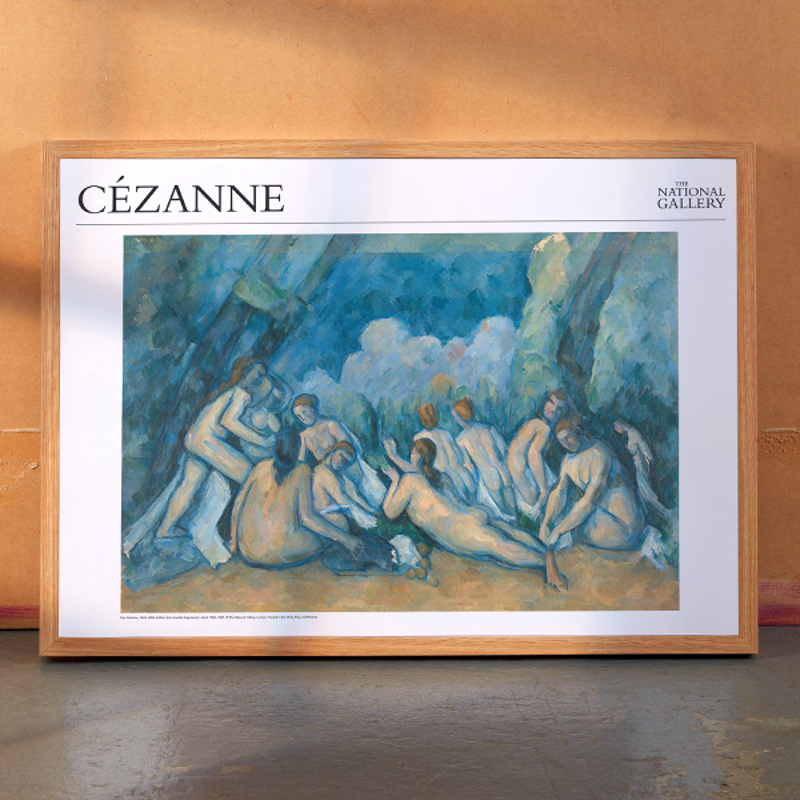Paris was very much at the heart of the avant-garde cultural world during these decades but there were other European centres which were also important. In 'After Impressionism' we focus on four of these: Barcelona, Berlin, Brussels and Vienna.
Barcelona
Ramón Casas i Carbó
'The Automobile', about 1900. Círculo del Liceu, Barcelona
Ramón Casas (1866–1932) came from a wealthy Catalan background. A painter and a graphic designer, he produced posters and advertisements as well as painting scenes of modern life. He was a leading figure in the Barcelona avant-garde.
He visited Paris for the first time in 1881 aged just 15 and began studying art. He continued to visit Paris throughout his life, as well as spending time in Madrid. A prime example of his work is the series of 12 paintings he completed for the private club Círculo del Liceu in Barcelona. The series in the building’s rotunda, shows scenes of modern musical life.
In this painting, ‘The Automobile’, a woman drives towards us. It’s a striking composition. We’re caught in the headlights; confronted by the vehicle’s bonnet with its lights shining out in contrast to the dark surroundings.
To anyone looking at this painting in its day, this would have been a very modern image – Casas puts the motor car, a new revolutionary machine, almost uncomfortably near to us in the foreground. This was possibly the first car to be seen in Barcelona, owned by the artist. Equally radical: it is being driven by a solo woman.
Casas was a car enthusiast from the start. He painted this work only a few years after the invention of the combustion engine, at a time when the manufacture of cars was expanding. There would have been increasing numbers of cars on the road; although accessible at this point only to the aristocracy and the wealthy bourgeoisie. Engineers and designers across Europe were developing models including the productions of the now famous Hispano-Suiza car company founded in Barcelona in 1904 by businessman Damián Mateu and Swiss engineer Birkigt.
Despite its title, the theme that links 'The Automobile' to all the other paintings in the series is not the motor car but music. In this case, a concert attended by our driver. As in many works in the series, the reference is included in the background. To the right, an orchestra plays in front of a building - the pavilion built by the Círculo for the Barcelona Universal Exhibition of 1888.
The commission for the Círculo del Liceu, with its elegant interior, a stone’s throw away from Barcelona’s magnificent Gran Teatro del Liceu, reflects Casas’s standing and influence as an artist. He was recognised in his lifetime as a leading figure in a new style of art – Catalan Modernism. The simplicity and modernity of this work gained the admiration of the young Picasso.
Brussels
Théo(phile) van Rysselberghe
‘The Scheldt upstream from Antwerp – evening’, 1892
We can follow this vibrant era in the development of art through the different groups of artists who came together across Europe, united by interests, stylistic developments and exhibitions. These were artistic movements with a cause that looked to the future rather than to the art of the past.
In Belgium, Les XX (Les Vingt in French which translates as ‘The Twenty’ in English) was an exhibition society founded in 1883 by 20 artists who wanted to break away from the conventional art establishment. Its ten annual shows included works by artists from around Europe and the USA, not just Belgium, and welcomed a range of styles.
In Théo van Rysselberghe’s (1862‒1926) painting ‘The Scheldt upstream from Antwerp – evening’ of 1892, we can see the exchange of new ideas about painting – in this case, between Paris and Brussels. Van Ryusselberghe would have seen Seurat’s ‘Sunday Afternoon on the Island of La Grande Jatte’ at the 8th Impressionist exhibition in Paris as well as in Brussels in a Les XX exhibition. Likewise, van Rysselberghe exhibited work in Paris’s Salon des Indépendants until 1906.
Seurat had developed a new technique of juxtaposing small dots of paint in primary and complementary colours to present a scientific translation of light. These small dots of colour oscillate to establish the overall tonality and atmosphere of the scene portrayed. This is called Neo-Impressionism.
Van Rysselberghe adapted Seurat’s technique for his own paintings using a colour palette that was dominated by purples, yellows and greens. In this painting, the upright vertical posts stand out in contrast to the yellow tones of the river. Their reflections in the rippling water are zigzags of purple and green dots broken up by dashes of golden yellow, cream and lilac.
Van Rysselberghe, like Seurat, would have known about Michel-Eugène Chevreul’s exposition of colour theory. He, like Seurat, was familiar with the arrangement of colours into a wheel which presented the three primary colours, and their complementary secondary colours.
By varying the density of the different colour combinations, van Rysselberghe recreates the intense orangey golden glow of the sky above the line of trees as the sun sinks below the horizon. For the plants in the foreground, he uses more upward short brushstrokes to differentiate weed from shadow. The painting’s frame too has been painted with dots of colour which complement the adjacent colour in the painting, making it an integral part of the work.
Vienna
Broncia Koller-Pinell
'The Artist’s Mother', 1907
Vienna too was home to a breakaway movement of non-conventional artists known as the Secession.
The artist Broncia Koller-Pinell (1863‒1934) might have been at a disadvantage as a woman in the arts at this time as women were not admitted to Vienna’s Academy of Fine Arts. She was lucky, however, as her interest in art was supported by her family and they were comfortably well off enough for her to learn privately. At 18 she studied in Vienna before moving to Munich where she continued to train for five years. The academies that she attended were designed to give proper professional training, and in both Berlin and Munich there were academies founded specifically for female students.
In 1903 she moved with her husband and two children to Vienna. The following year, she inherited the family house in Oberwaltersdorf, south of Vienna, where she set up a salon for Vienna’s artistic avant-garde. She regularly visited other artists’ studios and hosted gatherings in her own home. She was particularly close to Gustav Klimt, as well as Joseph Hoffmann and Koloman Moser, founding members of the Wiener Werkstätte (Vienna Workshops), a cooperative of painters, sculptors, architects and decorative artists who came together with the aim of reviving, even in everyday objects, the aesthetic quality of applied and decorative arts in the face of mass production.
In her painting ‘The Artist’s Mother’ of 1907, she shows her mother sitting outside with her needlework. The clematis and petunias tell us that it’s summer. Their simplified, stylised, organic form and the pattern created by the flowers’ faces and leaves are a clue to some of the many influences on Koller-Pinell’s work. The flat leaves and petals are like a graphic, floral fabric design in contrast to the more naturalistic approach to her mother’s face and dress. The gold background, the purples and the pinks remind us of Klimt’s paintings as does the stylisation of the flowers into decoration rather than description.
Koller-Pinell paints the side of the rattan chair which her mother is sitting in using a similar approach to the flowers. The regular gaps in the weave, where her mother’s dark dress fabric is visible, create a geometric, chequered effect. The small brown square-shaped openings (where the side of the chair shows through) in the white needlework of her mother mirrors this effect in miniature. Pattern and geometric shapes spilled over into other creative areas such as architecture, as we can see in the buildings of Otto Wagner in Vienna with their repeated square and rectangular-shaped windows and doors, and in the interior designs of Josef Hoffmann.
Koller-Pinell was well-known in her day and played an active part in the artistic community, but few are aware of her work today.
Berlin
Paula Modersohn-Becker
‘Seated Girl with a white Shirt and Standing Nude Girl’ 1906
Paula Modersohn-Becker (1876–1907) was a highly gifted and successful artist. She trained at the Drawing and Painting School of the Verein der Berliner Kuntslerinnen (Berlin Women’s Artist Association) after which she based herself in the artists community of Worpswede near Bremen.
She visited Paris four times between 1900 and 1906. In Paris she visited museums where she saw and studied Faiyum (Roman Egyptian) mummy portraits, Gothic sculptures, works by Rembrandt, the Impressionists and, significantly, paintings by Puvis de Chavannes, Cezanne and Gauguin. She also met Henri Rousseau and counted the Nabis as friends.
In this painting, made during what was to be her final stay in Paris in 1906, ‘Seated Girl with a white Shirt and Standing Nude Girl’ we see two young girls, one standing, one seated. They’re looking at each other, unaware of the artist drawing them.
What made this painting so new in its time is the pared-back composition of the two figures. We can’t make out the setting clearly: Modersohn-Becker has elaborated neither the setting nor the props. It’s not a painting about place but the tenderness of the gesture – the seated girl leaning forward as she puts her arm around the standing child.
Both figures are painted flatly, their shapes outlined in black. This reminds us of Gauguin’s non-naturalist approach in paintings such as in ‘Vision of the Sermon’ of 1888, also included in the exhibition. This simplified approach to painting the figures – the lack of objects and clothing – doesn’t detract from the impact of the painting but reinforces the intimate moment.
Modersohn-Becker did not live long after having painted this work. She became pregnant the following year and returned to Worpswede where she died just three weeks after having given birth to a daughter.


